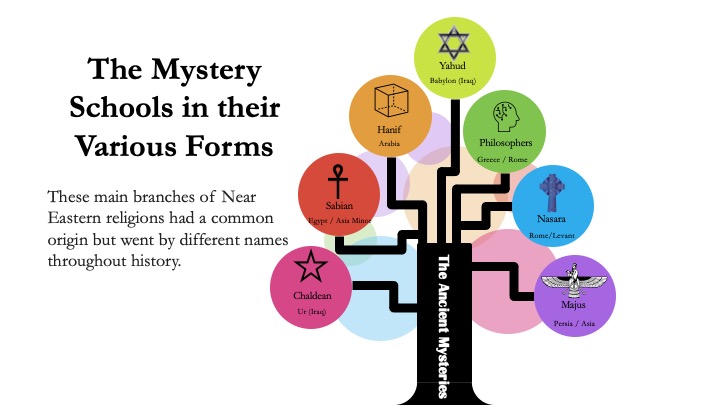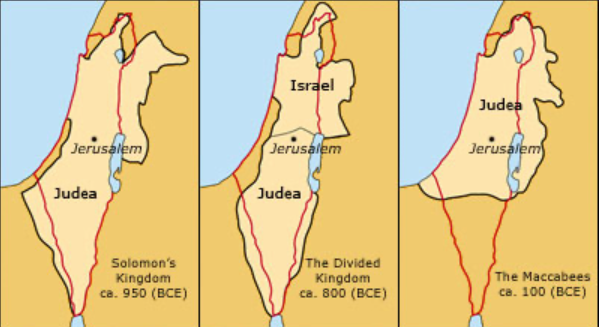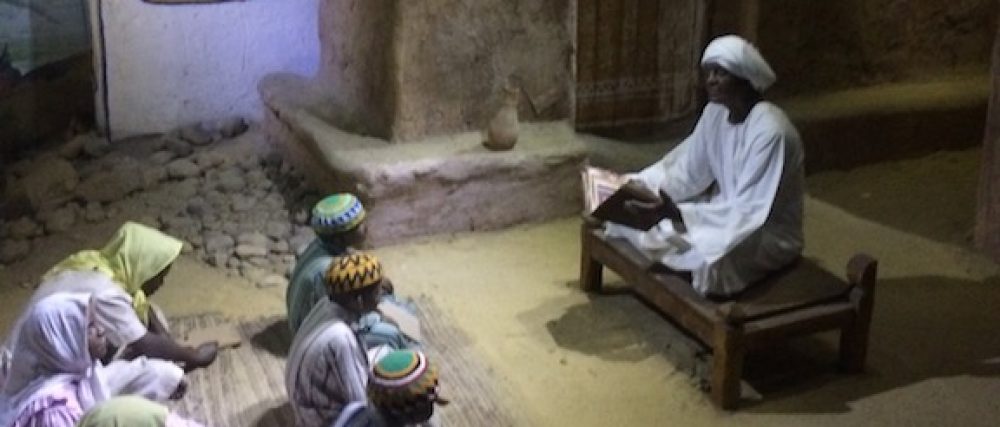If we cede that the primordial religion was a comprehensive spiritual and intellectual tradition resembling what we know as the Ancient Mystery Schools, then we should be able to map them to a single origin, whose name and appearance differed throughout time and space, but whose essence remained the same.To better illustrate the relationship between the major religions of the Near East and the Ancient Mystery Schools see the graphic below. Following that, I will provide a brief description of each of these names for Near Eastern religions with the aims of illuminating the similarities and differences.

Chaldeans
The priests of the Mystery Schools in Prophet Ibrahim’s day were referred to as the Chaldeans. This is the Latinized form of the Semitic term, Kasdīm. Seated in ancient Iraq, they were known for their knowledge of astrology and worshipful reverence of the stars. When they went astray, Ibrahim was sent to rectify their religion. Those that followed him were known as Ḥanīfs. The Muslim polymath, al-Fārābī believed that the Chaldeans were the first to harvest the “wisdom teachings,” which they transmitted to the Egyptians, who transmitted them to the Greeks, who transmitted them to the Syrians (i.e. Naṣārā), who ultimately transmitted them to the Arab Muslims (43).
Sabians
The leaders of the Mystery Schools of Egypt and the lands that fell under their rule were known as Sabians (Ṣābi’a). This is attested to in Mandaean sources as well as in hieroglyphics. Dr. Nadim al-Sayyar found in a papyrus scroll that the word for knowledge was ṣabāwi (صباوٍ), which is derived from the word ṣabā, which means guidance in the ancient Egyptian language. Moreover, another derivative of this root is the word for teachings, ṣabāyat, which also indicates a scripture or a message (Sayyār, 1995, 274-5). He also demonstrates that this root carried connotations to the stars (Sayyār, 2020, 142).
How this Egyptian term entered the Arabic lexicon is a matter of speculation, but it suffices us to say that historians writing in Arabic after the advent of Islam used the term to refer to the unreformed Mystery Schools and the antithesis to Ḥanīf. This is attested to by the Andalusian Jewish scholar, Maimonides in his Guide For the Perplexed, Ṣa’id al-Andalusī’s Biographies of the Nations, and Muhammad al-Shahrastānī’s Sects and Creeds.
Ḥanīfs
Though the term Ḥanīf referred to Ibrahim and his followers who taught an unwavering monotheism and deference to human prophets as opposed to the angels, the term was inverted by many Semitic languages and religions. Other groups took it to mean pagan among other things discussed in Part 10 of this series. The Arabic of the Qur’an corrected this understanding and freed Ibrahim of any allegations of polytheism (as discussed in Part 9).
In later Arabic writings, the term Ḥanīf could be understood as the reformed versions of the Mystery Schools guided by the prophets as opposed to the Sabians, who represented the unreformed versions. While Muslim jurists, theologians, and historians acknowledged that Sabian beliefs had a foundation in monotheism, they also invented ideas that misled the masses into polytheism. Therefore, later religions would lie on the continuum between Sabian, a kind of proto-polytheism, and Ḥanīf, an orthodox monotheism.
Yahūd
It is my understanding that the Bani Isra’il (the Children of Israel) represented the Ḥanīf opposition to Egyptian, Chaldean, and Arabian Sabianism, as expounded by Maimonides. The Yahūd, on the other hand, are frequently spoken of negatively in the Qur’an, in contrast to Bānī Isrā’īl. Thus it is plausible that the Yahūd were those Jewish priests who relapsed into the practices and beliefs of the Sabians, particularly those of Northern Arabia where the kingdoms of Israel and Judah (perhaps a cognate to the Arabic word, Yahūd) were located. As we know, the Kingdom of Judah was conquered by the Assyrians and fell under the influence of the Chaldeans of their day.
One should note that the Mandaean Sabians believed themselves to have once been of the Jews, who were called Yahutai in Aramaic. However, they were from the faction who doubted the immaculate conception of Miriam (Buckley, 4), meaning they contributed to the distortion of the revealed doctrine. It should also be noted that Madaeans see the ancient Yahutai (i.e. Yahūd) and the Chaldeans (their spiritual predecessors) as one and the same. This can account for the Qur’an’s repeated critique of the Yahūd and other Sabian-style beliefs. A deeper look into the language of the Qur’an will reveal that most of their mentions in the Qur’an refer to them as “those who claim to be Jews” (الذين هادوا) revealing that God is casting doubt on their claims.

Philosophers
The Greek Philosophers, though not mentioned directly in the Qur’an, are generally known as Sabians among Muslim scholars. Ibn Taymīya, for instance, stated as such in his Al-Radd ʿalā al-Shādhulī. He believed that the philosophers were originally rightly guided (al-Ṣābi’a al-Ḥunafā’), just as the Yahūd and Naṣārā were originally rightly guided. However, only those among them who did not contradict the prophets remained guided (Ibn Taymīya, 136-7). We should also note that the Greek philosophers are also most commonly associated with the Mystery Schools. The likes of Pythagoras, Socrates, and Zeno were all associated with versions of the Mysteries, although there were philosophers also not associated with a particular Mystery school.
Naṣārā
As discussed in Part 10 of this series, the Naṣārā were most likely the Nasoraeans, a Neo-Platonic priestly class that became infused with the prophetic lineage (i.e. Ḥanīf) following the advent of Īsā. They were apparently Judeo-Christian in their beliefs and practice, but they retained a philosophical element inherited from the Sabians that influenced their approach to the prophetic tradition. As such, God in the Qur’an rebukes those beliefs that came from the Sabians such as the Trinity, the divinity of Christ, and his sonship of God, while affirming the Ḥanīfs among them as Ahl al-Kitāb (People of the Book). The concepts of the Trinity, divination of man, and pantheism are all recurring themes in Sabianism and the ancient Egyptian, Greek, and Roman mysteries.
Majūs
As for the Majūs, they are only mentioned once in the Qur’an among those who claim to be Jews, Sabians, and Naṣārā. They were the priestly class of the Zoroastrians, the Persian Mystery Schools. Medieval European Biblical scholars referred to Zoroastrians as Eastern Chaldeans and Sabians (Elukin, 624).
The Abbasid court astrologer, Abū Sahl ibn Nawbakht, gives a testimony to the Persian Mysteries in Ibn al-Nadīm’s al-Fihrist. According to Abū Sahl, Hermes taught the “wisdom teachings” to the people of Babylon, which included present-day Iran, then he traveled to Egypt to teach to them. The knowledge taught by Hermes remained in Persia uninterrupted until the invasion of Alexander, in which he killed the leader Dara II, defaced the inscriptions on their buildings, and looted all their manuscripts. Alexander then took these works on medicine, astronomy, etc. and had them translated into Greek and Coptic, then burned the Persian originals. Following this catastrophe, the Persian kings began the process of reconstructing their knowledge by acquiring manuscripts from the peripheries of the Persian Empire like those of India and China and re-establishing their chains of transmission in Persia. This project persisted into the Muslim conquest of Persia and was continued until the height of the Abbasid empire (Ibn al-Nadīm, 333-4).
Summary
Now that we have provided a synopsis for each of these terms, we see that the common denominator is that these terms primarily referred to the learned class within their respective traditions, whose nomenclature varied depending on the locale and time period. Secondly, these traditions all had similar trajectories. For instance, they all excelled at the empirical and occult sciences, especially astrology. However, the standard for measuring the veracity of a tradition was how close it conformed to the Ḥanīf system, which was championed by the prophets, as opposed to the Sabian system, championed by the polytheists (i.e. Mushrikūn). Finally, many exegetes of the Qur’an interpreted al-Baqara: 62 and its cognate verses to mean: Whosoever affirms a belief in God as taught by the Prophet Muhammad among the Yahūd, Sabians, Naṣārā, and Majūs will not be treated unjustly by God in the end. An unraveling of this nomenclature and their respective beliefs has relevance for 21st century America. As many individuals, young and old, gravitate to expressions of Sabianism in one form or another, it is necessary to know where these ideas came from and the pre-modern debates that ensued around them. I will touch on these discussions in subsequent posts.
References
Buckley, Jorunn Jacobsen. The Mandaeans: Ancient Texts and Modern People. Oxford University Press, 2002.
Elukin, Jonathan. “Maimonides and the Rise and Fall of the Sabians: Explaining Mosaic Laws and the Limits of Scholarship.” Journal of the History of Ideas, vol. 63, no. 4, 2002, pp. 619–37. JSTOR, https://doi.org/10.2307/3654163.
Farabi al-. Al-Farabi’s Philosophy of Plato and Aristotle. Translated by Muhsin Mahdi, Free Press of Glencoe, 1962.
Ibn Nadīm, Abū al-Faraj Muḥammad ibn Isḥaq. Al-Fihrist. Dar al-Ma’rifah, 937.
Ibn Taymiyya, Taqī al-Dīn Abū’l-’Abbās Aḥmad, and ʿAlī Muhammad ʿUmrān. Al-Radd ʿalā al-Shādhulī Fī Ḥizbayhi Wa Mā Ṣannafahu Fī Ādāb al-Ṭarīq. Dār ʿĀlam al-Fawā’id, 2008.
Sayyār, Nadīm al-. Qudamāʼ Al-Misṛīyīn Awwal al-Muwahḥịdīn. 2nd ed., 1995.
Sayyār, Nadīm al-. Laysū Āliha Wa Lākin Malā’ika. 2020.

